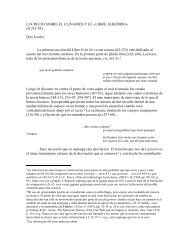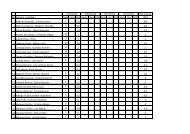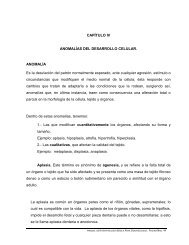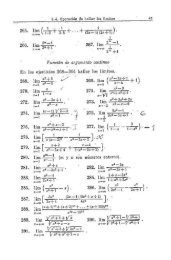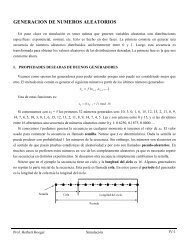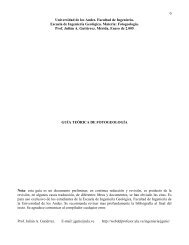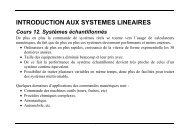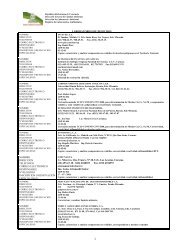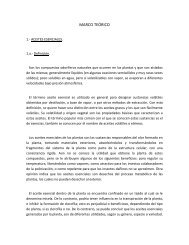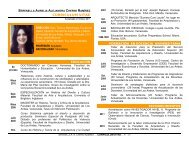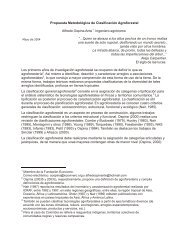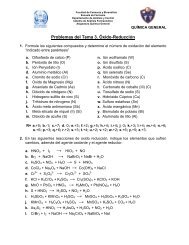Macrocyclic Ligands - Web del Profesor
Macrocyclic Ligands - Web del Profesor
Macrocyclic Ligands - Web del Profesor
You also want an ePaper? Increase the reach of your titles
YUMPU automatically turns print PDFs into web optimized ePapers that Google loves.
to six, the complex stability decreases. A detailed discussion<br />
of the thermodynamics of changing chelate sizes for tetraaza<br />
macrocycles can be found. 17,78<br />
M N<br />
N<br />
H H<br />
H<br />
H<br />
H<br />
H N<br />
M<br />
N N<br />
N<br />
(31) (32)<br />
N<br />
N<br />
H<br />
H<br />
An elegant example of the importance of conformational<br />
changes in tetradentate macrocycles is the blue to yellow<br />
conversion observed for nickel(II) complexes. The yellow<br />
form is the low-spin square planar complex NiL 2+ , while the<br />
blue form is high-spin pseudooctahedral [NiL(H2O)2] 2+ .In<br />
the blue to yellow conversion the Ni–N bonds contract, which<br />
compensates for the breaking of the axial Ni–OH2 bonds. The<br />
reaction is controlled by entropy, and the addition of an inert<br />
salt is such as to favor the dissociation of the water molecules.<br />
At equilibrium in aqueous solution, both [12]aneN4 (cyclam)<br />
(1) and the 15-membered analog, [15]aneN4, have 99% of<br />
the high-spin form present, while the 13- and 14-membered<br />
macrocycles exist in predominantly the low-spin square planar<br />
form (87 and 71%, respectively). 79<br />
For the nonplanar octahedral cis-coordinated macrocycles<br />
[n]aneN4, changes in the ligand field correlate well with the<br />
analogous ligand field strengths for nonmacrocyclic analogs,<br />
specifically as related to the chelate ring size. A general rule<br />
of thumb is that increasing the chelate ring size from five<br />
to six increases the stability of complexes of smaller metals<br />
compared to larger metal ions. The origin of this effect can be<br />
attributed to increases in ring strain energy when metal ions<br />
larger than tetrahedral carbon are part of the ring. 78 For the<br />
planar-coordinated macrocycles, the equatorial ligand field,<br />
as anticipated, is dependent on the ring size. These findings<br />
have been related to the calculation of the optimum hole size<br />
permitting the macrocycle to adopt its most preferable endo<br />
configuration. Thus, it has been found that the macrocyclic<br />
hole size increases by 10–15 pm for each increment in n for<br />
[n]aneN4. 79<br />
In order to introduce a greater rigidity into the<br />
flexible polyaza macrocycles and to implement greater<br />
hole size–metal ion size match correlations, reinforced<br />
macrocycles such as (33) have been created, which contain<br />
fused diaza rings. 80 Crystallographic results for the nickel(II)<br />
complex indicate that the Ni–N bonds are shortened from<br />
the strain-free value of 1.91 ˚A for diamagnetic nickel to<br />
1.86 ˚A. Ligand field strength is also found to increase, and<br />
this has been suggested as being due to the compression<br />
of the bond lengths 80 as well as the presence of tertiary<br />
nitrogen donors. 78 In a more recent comparative study of<br />
nickel macrocycles with two fused 1,3-diazacyclohexane rings<br />
(35) compared to two fused 1,3-diazacyclopentane rings (34),<br />
MACROCYCLIC LIGANDS 11<br />
structural results revealed weaker ligand field strengths for the<br />
1,3-diazacyclohexane compared to 1,3-diazacyclopentane. 54<br />
N<br />
N<br />
NH HN<br />
(33)<br />
N<br />
NH<br />
N<br />
N<br />
(34)<br />
HN<br />
N<br />
N<br />
NH<br />
N<br />
N<br />
(35)<br />
HN<br />
Attempts to achieve macrocycles that are capable of<br />
stabilizing highly oxidized transition metal complexes has<br />
led to the design of ‘noninnocent’ ligands. 81 The structures of<br />
high-valent chromium(V) oxo species with the two tetraamido<br />
N ligands (36)and(37) were determined. Both structures were<br />
found to contain distinctly nonplanar amide groups, and in<br />
(36) all four amides are nonplanar.<br />
O<br />
NH<br />
NH<br />
O<br />
HN<br />
HN<br />
O<br />
Cl Cl<br />
NH<br />
N<br />
O NH HN O<br />
(36) (37)<br />
HN<br />
Polyaza macrocycles with pendant arms have been studied<br />
extensively, in particular with respect to protonation and<br />
complexation as well as to the kinetics of metal complex<br />
formation. These aspects are treated in a review by Kaden. 11<br />
Of particular interest is the fact that metal complex formation<br />
constants of macrocycles with pendant carboxylates can be<br />
10 3 to 10 4 times higher than for the unsubstituted analogs.<br />
4.2.3 Higher Polyaza Macrocycles<br />
Transition metal complexes of the larger polyaza<br />
macrocyclic ligands have been less extensively studied than<br />
for the smaller ring systems. For the pentaaza macrocycles,<br />
[15]aneN5 with ethylene bridges appears to form the most<br />
stable complexes with most metal ions. 17 Structural data<br />
for a variety of pentaaza macrocyclic complexes have<br />
been reviewed. 16 The N–H bonds as well as the different<br />
sized chelate rings must be considered in calculating the



